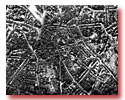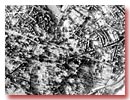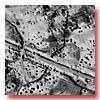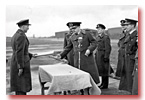 |
||||||||||||
|
Royal Air Force Bomber Command 60th AnniversaryCampaign Diary
|
||||||||||||
| Solingen - Before and After | |

|

|
5/6 November 1944
65 Mosquitos to Stuttgart - in 2 waves - and 6 to Aschaffenburg. No aircraft lost.
6 November 1944
Gelsenkirchen: 738 aircraft - 383 Halifaxes, 324 Lancasters, 31 Mosquitos. 3 Lancasters and 2 Halifaxes lost. This large daylight raid had, as its aiming point, the Nordstern synthetic-oil plant. The attack was not well concentrated but 514 aircraft were able to bomb the approximate position of the oil plant before smoke obscured the ground; 187 aircraft then bombed the general town area of Gelsenkirchen.
1 Wellington flew an RCM sortie.
6/7 November 1944
235 Lancasters and 7 Mosquitos of No 5 Group attempted to cut the Mittelland Canal at its junction with the Dortmund-Ems Canal at Gravenhorst. The marking force experienced great difficulty in finding the target. The crew of a low-flying Mosquito - pilot: Flight Lieutenant LCE De Vigne; navigator: Australian Squadron Leader FW Boyle, No 627 Squadron - found the canal and dropped their marker with such accuracy that it fell into the water and was extinguished. Only 31 aircraft bombed, before the Master Bomber ordered the raid to be abandoned. 10 Lancasters were lost.
128 Lancasters of No 3 Group to the new target of Koblenz, making a night G-H attack. 2 Lancasters lost. This was a successful raid with most of the damage being caused by a large area of fire in the centre of the town. The British Bombing Survey Unit later estimated that 303 acres, 58 per cent of the town's built-up area, were destroyed.
48 Mosquitos to Gelsenkirchen, 18 to Hannover, 11 to Rheine and 8 to Herford, 32 RCM sorties, 82 Mosquito patrols, 12 Lancasters minelaying off Heligoland. 4 aircraft lost - 1 Mosquito from the Gelsenkirchen raid, 2 Mosquito Intruders and 1 RCM Fortress.
7 November 1944
1 Wellington flew an uneventful RCM sortie.
8 November 1944
136 Lancasters of No 3 Group attacked the Meerbeck oil plant at Homberg. 1 Lancaster lost. The raid opened well and 2 large fires were seen but smoke then concealed the target and later bombing was scattered.
1 Wellington RCM sortie.
8/9 November 1944
59 Mosquitos to Herford and 50 to Hannover, 4 RCM sorties, 24 aircraft on Resistance operations. 2 Stirlings on Resistance work were lost.
9 November 1944
256 Lancasters and 21 Mosquitos of Nos 1 and 8 Groups to attack the Wanne-Eickel oil refinery. Cloud over the target was found to reach 21,000 ft and the skymarkers dropped by the Oboe Mosquitos disappeared as soon as they ignited so the Master Bomber ordered the force to bomb any built-up area. The town of Wanne-Eickel reports only 2 buildings destroyed, with 4 civilians and 6 foreigners killed. It must be assumed that other towns in the Ruhr were hit but no details are available. 2 Lancasters lost.
9/10 November 1944
6 Mosquitos each to Gotha and Pforzheim, 4 to Schwelm (which was not reached) and 3 to Kassel, 22 aircraft of 100 Group on a Window feint to draw up German fighters, 8 Mosquito patrols, 3 Stirlings on Resistance operations. No aircraft lost.
10 November 1944
2 Wellington RCM sorties, 2 Mosquito Rangers. No losses.
10/11 November 1944
59 Mosquitos to Hannover and 4 each to Gotha and Erfurt (Erfurt was not reached), 30 RCM sorties, 40 Mosquito patrols. 1 Mosquito from the Hannover raid was lost.
11 November 1944
122 Lancasters of No 3 Group carried out a G-H attack on the synthetic-oil refinery at Castrop-Rauxel. The bombing was believed to be accurate and no aircraft were lost.
2 Wellington RCM sorties.
11/12 November 1944
Harburg: 237 Lancasters and 8 Mosquitos of No 5 Group. 7 Lancasters lost. The aiming point for this raid was the Rhenania-Ossag oil refinery, which had been attacked several times by American day bombers.
Dortmund: 209 Lancasters and 19 Mosquitos of Nos 1 and 8 Groups. No aircraft lost. The aiming point was the Hoesch Benzin synthetic-oil plant in the Wambel district. A local report confirms that the plant was severely damaged. Other bombs hit nearby housing and the local airfield.
41 Mosquitos to the Kamen oil refinery, 12 to Osnabrück, 9 to Wiesbaden, 6 to Gotha and 3 to Erfurt, 36 RCM sorties, 59 Mosquito patrols, 26 Lancasters and 24 Halifaxes minelaying off Oslo, in the Kattegat and in the River Elbe. No aircraft lost.
12 November 1944
30 Lancasters of Nos 9 and 617 Squadrons and a No 463 Squadron Lancaster with cameramen on board flew from Lossiemouth to attack the Tirpitz, which was still moored near Tromso. The weather was clear. Tirpitz was hit by at least 2 Tallboys and then suffered a violent internal explosion. She capsized to remain bottom upwards - a total loss. Approximately 1,000 of the 1,900 men on board were killed or injured. German fighters which were stationed near by to protect the Tirpitz failed to take off in time and only 1 Lancaster, of No 9 Squadron, was severely damaged, by flak; it landed safely in Sweden with its crew unhurt.
2 RCM sorties, 2 Mosquitos on Ranger patrols. No losses.
13 and 14 November 1944
1 Wellington flew an uneventful signals patrol on each of these days.
15 November 1944
177 Lancasters of No 3 Group carried out a G-H attack on the oil plant at Dortmund. The raid, through thick cloud, was believed to have been accurate. 2 Lancasters lost.
5 RCM sorties, 2 Ranger patrols to the Copenhagen area. No losses.
15/16 November 1944
36 Mosquitos to Berlin, 6 each to Gotha and Wanne-Eickel, 5 to Karlsruhe and 4 to Scholven/Buer, 29 RCM sorties, 30 Mosquito patrols. 1 Mosquito lost from the Berlin raid.
16 November 1944
Bomber Command was asked to bomb 3 towns near the German lines which were about to be attacked by the American First and Ninth Armies in the area between Aachen and the Rhine. 1,188 Bomber Command aircraft attacked Düren, Jülich and Heinsburg in order to cut communications behind the German lines. Düren was attacked by 485 Lancasters and 13 Mosquitos of Nos 1, 5 and 8 Groups, Jülich by 413 Halifaxes, 78 Lancasters and 17 Mosquitos of Nos 4, 6 and 8 Groups and Heinsberg by 182 Lancasters of No 3 Group. 3 Lancasters were lost on the Düren raid and 1 Lancaster on the Heinsberg raid. 1,239 American heavy bombers also made raids on targets in the same area, without suffering any losses. More than 9,400 tons of high-explosive bombs were dropped by the combined bomber forces. The American advance was not a success. Wet ground prevented the use of tanks and the American artillery units were short of ammunition because of supply difficulties. The infantry advance was slow and costly.
18 November 1944
479 aircraft - 367 Halifaxes, 94 Lancasters, 18 Mosquitos - of Nos 4, 6 and 8 Groups to Münster. 1 Halifax crashed in Holland. The raid was not concentrated and bombs fell in all parts of Münster.
3 Halifaxes flew RCM sorties.
18/19 November 1944
Wanne-Eickel: 285 Lancasters and 24 Mosquitos of Nos 1 and 8 Groups. 1 Lancaster lost. The intention of the raid was to hit the local oil plant. Large explosions seemed to erupt in the plant and post-raid reconnaissance showed that some further damage was caused to it. The local report does not mention the oil plant but states that the Hannibal coal mine was destroyed.
31 Mosquitos to Wiesbaden (a 'spoof' raid), 21 to Hannover and 6 to Erfurt, 29 RCM sorties, 44 Mosquito patrols. No aircraft lost.
19 November 1944
1 Hudson Resistance flight.
20 November 1944
183 Lancasters of No 3 Group made a G-H attack on the oil plant at Homberg but the weather was stormy and many aircraft were not able to maintain formation with the G-H aircraft on the bombing run. The bombing, through cloud, was believed to have been scattered. 5 Lancasters lost.
3 RCM sorties, 2 Mosquito Ranger patrols, 3 Hudsons on Resistance operations. No aircraft lost.
20/21 November 1944
43 Lancasters of No 8 Group made an unusual Pathfinder solo raid on Koblenz without loss. The purpose of the raid was not recorded. It is possible that either the large road and rail bridges over the Rhine and Mosel or the local railway yards were the targets. Only high-explosive bombs were carried. Koblenz was completely covered by cloud and all bombing was by H2S from 15,000 ft. The local report states that some bombs fell in the town, blocking several roads and railways and scoring hits on a road and a rail bridge, although these remained usable.
63 Mosquitos to Hannover, 14 each to Homberg and Castrop-Rauxel oil plants and 9 to Eisenach, 17 RCM sorties, 17 Mosquito patrols. No aircraft lost.
21 November 1944
160 Lancasters of No 3 Group to attack the Homberg oil refinery. 3 Lancasters lost. The bombing was scattered at first but then became very concentrated, culminating, according to the Bomber Command report, in 'a vast sheet of yellow flame followed by black smoke rising to a great height'. This was a very satisfactory raid after several previous attempts by Bomber Command to destroy this oil refinery.
2 Wellingtons on RCM sorties.
21/22 November 1944
This was a night of mainly good visibility in which Bomber Command operations were directed strictly according to priorities given in recent directives.
Aschaffenburg: 274 Lancasters and 9 Mosquitos of Nos 1 and 8 Groups. 2 Lancasters lost. The object of this raid was to destroy the local railway yards and lines. The local report says that 50 bombs fell in the railway area, causing much damage to the marshalling yards and railway workshops but the: main through lines were not cut. Many other bombs fell in the centre and north of the town. About 500 houses were destroyed and 1,500 seriously damaged. Many old buildings were hit, including the local castle, the Johannisburg, which was hit by 5 high-explosive bombs and had a 4,000lb 'blockbuster' burst near by; the roof and upper storeys of the castle were burnt out.
Castrop-Rauxel: 273 aircraft - 176 Halifaxes, 79 Lancasters, 18 Mosquitos - of Nos 1, 6 and 8 Groups. 4 Halifaxes lost. The target was the oil refinery. The local report says that 216 high-explosive bombs, 78 duds and many incendiaries hit the oil plant and caused such a large fire that the fire-fighters could do little more than allow it to burn itself out. It is believe that the refinery produced no more oil after this raid. Bombs fell in many other places, including some important industrial and coal-mining premises.
Sterkrade: 270 aircraft - 232 Halifaxes, 20 Mosquitos, 18 Lancasters - of 4 and 8 Groups. 2 Halifaxes lost. The target was again the synthetic-oil refinery. Bomber Command's report says that the plant was not damaged, though some labour barracks near by were hit.
Mittelland Canal: 138 Lancasters and 6 Mosquitos of No 5 Group. 2 Lancasters lost. The canal banks were successfully breached near Gravenhorst. Later photographs showed that water drained off over a 30 mile stretch and that 59 barges were stranded on one short section alone.
Dortmund-Ems Canal: 123 Lancasters and 5 Mosquitos of No 5 Group. No aircraft lost. The canal near Ladbergen was attacked, some of the Lancasters coming down to 4,000ft to get beneath the cloud. A breach was made in the only branch of the aqueduct here which had been repaired since the last raid and the water once again drained out of the canal.
29 Mosquitos to Stuttgart, 26 to Hannover, 19 to Worms and 4 to Wesel, 38 RCM sorties, 80 Mosquito patrols, 24 Halifaxes and 18 Lancasters minelaying off Oslo, 9 aircraft on Resistance operations. 4 aircraft were lost - 2 Mosquitos and 1 Halifax of No 100 Group and 1 Lancaster from the minelaying force.
Total effort for the night: 1,345 sorties, 14 aircraft (1.0 per cent) lost.
| Mitteland Canal Breached |

|
22 November 1944
1 Wellington RCM sortie and 1 Hudson Resistance flight. No losses.
| The Fellowship of the Bellows | |

|

|
22/23 November 1944
171 Lancasters and 7 Mosquitos of No 5 Group were dispatched to attack the U-boat pens at Trondheim but the target was covered by a smoke-screen and the Master Bomber ordered the raid to be abandoned after the illuminating and marking force had been unable to find the target. 2 Lancasters and 1 Mosquito lost.
17 Lancasters minelaying off Heligoland and in the mouth of the River Elbe without loss.
23 November 1944
168 Lancasters of No 3 Group carried out a G-H raid through cloud on the Nordstern oil plant at Gelsenkirchen. The bombing appeared to be accurate. 1 Lancaster lost.
4 Mosquitos on Ranger patrols in the Heligoland area, 1 Hudson on a Resistance operation. No aircraft lost.
23/24 November 1944
61 Mosquitos to Hannover, 9 to Eisenach and 6 each to Gottingen and Hagen, 43 aircraft of No 100 Group on RCM and Mosquito operations (separate figures not available). 1 Mosquito lost from the Hannover raid.
24 November 1944
1 Wellington RCM sortie and 1 Hudson Resistance flight.
24/25 November 1944
58 Mosquitos to Berlin and 6 to Gottingen, 13 Halifaxes minelaying off Denmark. No aircraft lost.
25/26 November 1944
68 Mosquitos to Nuremberg, 10 to Hagen and 9 each to Erfurt and Stuttgart, 36 RCM sorties, 38 Mosquito patrols. 1 Mosquito lost from the Nuremberg raid.
26 November 1944
75 Lancasters of No 3 Group were sent on a trial raid to attack the railway centre at Fulda to establish whether G-H signals could reach to this distance, 160 miles from the German frontier. The distance was too great, however, and the bombs were scattered over a wide area. No aircraft lost.
1 Hudson flew a Resistance operation.
26/27 November 1944
Munich: 270 Lancasters and 8 Mosquitos of No 5 Group. 1 Lancaster crashed in France. Bomber Command claimed this as an accurate raid in good visibility with much fresh damage, particularly to railway targets. It has not been possible to obtain a local report.
7 Mosquitos to Erfurt and 6 to Karlsruhe (a 'spoof' raid), 20 RCM sorties, 20 Mosquito patrols, 31 aircraft on Resistance operations. 1 Intruder Mosquito was lost and 1 Hudson on a Resistance flight crashed behind Allied lines in Belgium.
27 November 1944
169 Lancasters of No 3 Group carried out a G-H raid on the Kalk Nord railway yards at Cologne. Good results were observed. 1 Lancaster lost.
27/28 November 1944
341 Lancasters and 10 Mosquitos of Nos 1 and 8 Groups despatched to Freiburg. 1 Lancaster lost. Freiburg was not an industrial town and had not been bombed before by the RAF It was attacked on this night because it was a minor railway centre and because many German troops were believed to be present in the town; American and French units were advancing in the Vosges, only 35 miles to the west. The marking of the medium-sized town was based on Oboe directed from caravans situated in France. Flak defences were light and 1,900 tons of bombs were dropped on Freiburg in 25 minutes. Photographs showed that the railway targets were not hit but that the main town area was severely damaged.
290 aircraft - 173 Halifaxes, 102 Lancasters, 15 Mosquitos - of Nos 1, 6 and 8 Groups to Neuss. 1 Mosquito lost. The central and eastern districts of Neuss were heavily bombed and many fires were started.
67 Mosquitos to Berlin, 7 each to Hallendorf and Ludwigshafen and 5 to Nuremberg, 35 RCM sorties, 61 Mosquito patrols, 18 Halifaxes and 12 Lancasters minelaying off Danish and Norwegian coasts. No aircraft lost.
Total effort for the night: 853 sorties, 2 aircraft (0.2 per cent) lost.
28/29 November 1944
Essen: 316 aircraft - 270 Halifaxes, 32 Lancasters, 14 Mosquitos - of Nos 1, 4 and 8 Groups. No aircraft lost. Bomber Command documents claim further damage to industrial areas, including the Krupps works. An interesting little item in the local fire brigade report congratulates the team working in the burning headquarters of the local Gestapo for saving valuable documents.
145 Lancasters of No 3 Group and 8 Lancasters of No 1 Group carried out a mainly G-H attack on Neuss. No aircraft lost.
75 Mosquitos to Nuremberg and 9 to Hallendorf, 35 RCM sorties, 3 Mosquito patrols. 1 Mosquito lost from the Nuremberg raid.
Total effort for the night: 623 sorties, 1 aircraft (0.2 per cent) lost.
29 November 1944
Dortmund: 294 Lancasters and 17 Mosquitos of Nos 1 and 8 Groups. 6 Lancasters lost. Bad weather caused the marking and resultant bombing to be scattered but fresh damage was caused in Dortmund.
30 Mosquitos of No 8 Group attempted to bomb a tar and benzol plant in the Meiderich district of Duisburg, using the Oboe-leader method for the first time on a German target, but 2 of the 3 formations of Mosquitos failed to link up with their Oboe leaders and bombed on timed runs from the docks south of Duisburg. Most of the bombs were believed to have fallen beyond the target. No Mosquitos lost.
1 Hudson flew a Resistance operation.
29/30 November 1944
67 Mosquitos to Hannover and 4 to Bielefeld, 27 RCM sorties, 38 Mosquito patrols, 19 aircraft on Resistance operations. 6 Mosquitos of No 5 Group to lay mines in the River Weser were unable to carry out the operation because of 10/10ths cloud over the target area. No aircraft lost.
30 November 1944
60 Lancasters of No 3 Group attacked a coking plant at Bottrop without loss.
60 Lancasters of No 3 Group attacked a benzol plant at Osterfeld. 2 Lancasters lost.
39 Mosquitos of No 8 Group attacked the oil plant at Meiderich without loss.
30 November/1 December 1944
Duisburg: 576 aircraft - 425 Halifaxes, 126 Lancasters, 25 Mosquitos - of Nos 1, 4, 6 and 8 Groups. 3 Halifaxes lost. The target area was completely cloud-covered and the attack was not concentrated but much fresh damage was still caused.
53 Mosquitos to Hamburg and 7 to Hallendorf, 88 aircraft of No 100 Group on RCM and Mosquito operations (separate figures not available), 9 aircraft on Resistance operations. 1 Intruder Mosquito lost.
Total effort for the night: 733 sorties, 4 aircraft (0.5 per cent) lost.
|
|

|
Date Last Updated : Wednesday, April 6, 2005 2:40 AM
[ Aircraft | Background
| Commanders | Diary
| Anatomy | Groups
]
[ Famous Raids | Gallery
| Squadrons | Stations
]
[ Home ]
[ Return to the RAF Site ]
© Crown Copyright 2004 and © Deltaweb International Ltd 2004